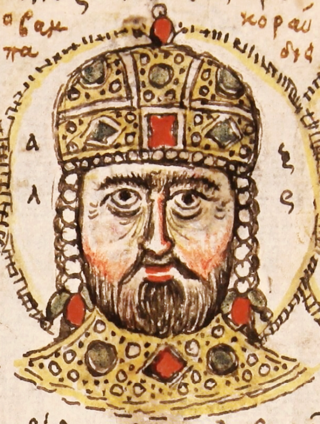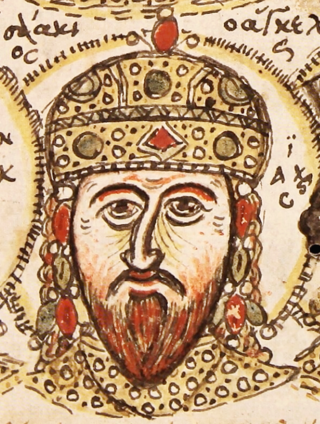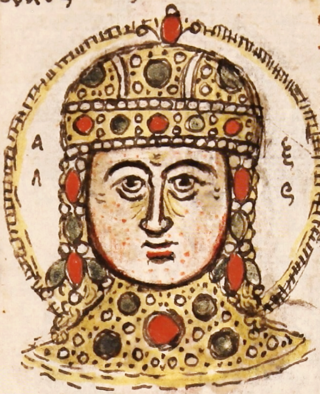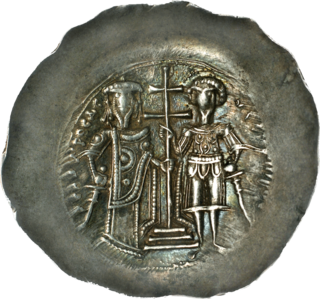Related Research Articles

Alexios V Doukas, Latinized as Alexius V Ducas, was Byzantine emperor from February to April 1204, just prior to the sack of Constantinople by the participants of the Fourth Crusade. His family name was Doukas, but he was also known by the nickname Mourtzouphlos or Murtzuphlus (Μούρτζουφλος), referring to either bushy, overhanging eyebrows or a sullen, gloomy character. He achieved power through a palace coup, killing his predecessors in the process. Though he made vigorous attempts to defend Constantinople from the crusader army, his military efforts proved ineffective. His actions won the support of the mass of the populace, but he alienated the elite of the city. Following the fall, sack, and occupation of the city, Alexios V was blinded by his father-in-law, the ex-emperor Alexios III, and later executed by the new Latin regime. He was the last Byzantine emperor to rule in Constantinople until the Byzantine recapture of Constantinople in 1261.

Isaac II Angelos or Angelus was Byzantine Emperor from 1185 to 1195, and co-Emperor with his son Alexios IV Angelos from 1203 to 1204. In a 1185 revolt against the Emperor Andronikos Komnenos, Isaac seized power and rose to the Byzantine throne, establishing the Angelos family as the new imperial dynasty.

Theodore I Laskaris or Lascaris was the first emperor of Nicaea—a successor state of the Byzantine Empire—from 1205 to his death. Although he was born to an obscure aristocratic family, his mother was related to the imperial Komnenos clan. He married Anna, a younger daughter of Emperor Alexios III Angelos in 1200. He received the title of despot before 1203, demonstrating his right to succeed his father-in-law on the throne.

The Fourth Crusade (1202–1204) was a Latin Christian armed expedition called by Pope Innocent III. The stated intent of the expedition was to recapture the Muslim-controlled city of Jerusalem, by first defeating the powerful Egyptian Ayyubid Sultanate. However, a sequence of economic and political events culminated in the Crusader army's 1202 siege of Zara and the 1204 sack of Constantinople, rather than the conquest of Egypt as originally planned. This led to the Partitio terrarum imperii Romaniae or the partition of the Byzantine Empire by the Crusaders and their Venetian allies leading to a period known as Frankokratia, or "Rule of the Franks" in Greek.

Henry was Latin emperor of Constantinople from 1205 until his death in 1216. He was one of the leaders of the Fourth Crusade in which the Byzantine Empire was conquered and Latin Empire formed.

Nicomedia was an ancient Greek city located in what is now Turkey. In 286, Nicomedia became the eastern and most senior capital city of the Roman Empire, a status which the city maintained during the Tetrarchy system (293–324).

The Latin Empire, also referred to as the Latin Empire of Constantinople, was a feudal Crusader state founded by the leaders of the Fourth Crusade on lands captured from the Byzantine Empire. The Latin Empire was intended to replace the Byzantine Empire as the Western-recognized Roman Empire in the east, with a Catholic emperor enthroned in place of the Eastern Orthodox Roman emperors. The main objective of the Latin Empire was planned by Venice, which promoted the creation of this state for their self-benefit.

Alexios IV Angelos, Latinized as Alexius IV Angelus, was Byzantine Emperor from August 1203 to January 1204. He was the son of Emperor Isaac II Angelos and his first wife, an unknown Palaiologina, who became a nun with the name Irene. His paternal uncle was his predecessor Emperor Alexios III Angelos. He is widely regarded as one of the worst Byzantine emperors for calling upon the Fourth Crusade to help him gain power, which ultimately led to the sack of Constantinople.
Kaloyan or Kalojan, also known as Ivan I, Ioannitsa or Johannitsa, the Romanslayer, was emperor or tsar of Bulgaria from 1196 to 1207. He was the younger brother of Theodor and Asen, who led the anti-Byzantine uprising of the Bulgarians and Vlachs in 1185. The uprising ended with the restoration of Bulgaria as an independent state. He spent a few years as a hostage in Constantinople in the late 1180s. Theodor, crowned Emperor Peter II, made him his co-ruler after Asen was murdered in 1196. A year later, Peter was also murdered, and Kaloyan became the sole ruler of Bulgaria.
Theodore Branas or Vranas, sometimes called Theodore Komnenos Branas, was a general under the Byzantine Empire and afterwards under the Latin Empire of Constantinople. Under the Latin regime he was given the title Caesar and in 1206 he became governor and lord of Adrianople. He is called Livernas by western chroniclers of the Fourth Crusade, including Geoffroi de Villehardouin.

The Empire of Nicaea or the Nicene Empire was the largest of the three Byzantine Greek rump states founded by the aristocracy of the Byzantine Empire that fled when Constantinople was occupied by Western European and Venetian armed forces during the Fourth Crusade, a military event known as the Sack of Constantinople. Like the other Byzantine rump states that formed due to the 1204 fracturing of the empire, such as the Empire of Trebizond and the Despotate of Epirus, it was a continuation of the eastern half of the Roman Empire that survived well into the medieval period. A fourth state, known in historiography as the Latin Empire, was established by an army of Crusaders and the Republic of Venice after the capture of Constantinople and the surrounding environs.
The Battle of Pelagonia or Battle of Kastoria took place in early summer or autumn 1259, between the Empire of Nicaea and an anti-Nicaean alliance comprising Despotate of Epirus, Kingdom of Sicily and the Principality of Achaea. It was a decisive event in the history of the Eastern Mediterranean, ensuring the eventual reconquest of Constantinople and the end of the Latin Empire in 1261.

Michael I Komnenos Doukas, Latinized as Comnenus Ducas, and in modern sources often recorded as Michael I Angelos, a name he never used, was the founder and first ruler of the Despotate of Epirus from c. 1205 until his assassination in 1214/15.
AlexiosBranas or Vranas was a Byzantine nobleman, attempted usurper, and the last Byzantine military leader of the 12th century to gain a notable success against a foreign enemy.

The House of Laskaris, Latinized as Lascaris, was a Byzantine Greek noble family which rose to prominence during the late Byzantine period. The members of the family formed the ruling dynasty of the Empire of Nicaea, a Byzantine rump state that existed from the 1204 sack of Constantinople by the Fourth Crusade until the restoration of the Empire under the Palaeologan dynasty in 1261.
David Komnenos was one of the founders of the Empire of Trebizond and its joint ruler together with his brother Alexios until his death. At least two lead seals and an inscription found on a tower in Heraclea Pontica attest that he was the first of his family to use the style Megas Komnenos. Ηe was the son of Manuel Komnenos and grandson of the Emperor Andronikos I.

Constantine Laskaris may have been Byzantine Emperor for a few months from 1204 to early 1205. He is sometimes called "Constantine XI", a numeral now usually reserved for Constantine Palaiologos.

The battle of Rusion occurred in the winter of 1206 near the fortress of Rusion between the armies of the Bulgarian Empire and the Latin Empire of Byzantium. The Bulgarians scored a major victory.

The Battle of Poimanenon or Poemanenum was fought in early 1224 between the forces of the two main successor states of the Byzantine Empire; the Latin Empire and the Byzantine Greek Empire of Nicaea. The opposing forces met at Poimanenon, south of Cyzicus in Mysia, near Lake Kuş.
Constantine Mesopotamites was a senior Byzantine official, and de facto chief minister under the emperors Isaac II Angelos and Alexios III Angelos from 1193 until his fall in summer 1197. He was also archbishop of Thessalonica from c. 1197 until c. 1227, but was in exile between 1204 and 1224, when the city was occupied by Latin Crusaders. Restored to his see, he refused to crown Theodore Komnenos Doukas as emperor, and departed his see again in self-exile. He was also a colleague and correspondent of the historian Niketas Choniates, and may have commissioned some of the latter's works.